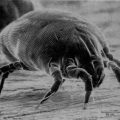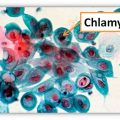Hydatid disease - is a rare parasitic disease, occurring in humans. It causes its larval form of a tape helminth Echinococcus granulosus. It can affect any organ, but often suffer from liver and lungs. If the larva is not delayed in the liver or the lung, it can be attached to any other organ, Located in a large circle of blood circulation. The greatest incidence of this disease was in the countries, whose main occupation - agriculture.
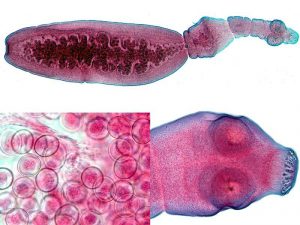
Echinococcus - what is it?
to understand, What is this disease, It is important to know, what echinococcus. Echinococcus - a tapeworm length about 5 mm, scolex having suction and crown, neck and segments. Sexually mature forms parasitize only in animals: dogs, wolves, foxes, jackals. They are the definitive hosts. A cyst, instar, present in intermediate hosts. These include cattle, sheeps, goats and other herbivores and omnivores, as well as people.
The cycle of development is such echinococcus: its primary owner - the jackal, Fox, a wolf or a dog, in the small intestine where it is a parasite. The adult head consists of Echinococcus, and cervical segments. A total of four segments, and the last one is a mature. It is separated from the worm and egg rolls, which are displayed along with the feces of an animal. Thus the eggs of the parasite are released and now they are easy to catch. Besides hexacanth have good endurance. Then, entering the body intermediate host, larva begins to develop. Once it gets to the final master - carnivorous animals by eating them contaminated meat. Since the life cycle of Echinococcus can continue only after ingestion of the definitive host, and its infection occurs by eating meat or organs of infected animals, A man is a biological dead end.
Distinguish gidatiozny echinococcosis - a single-chamber bubble, which is usually found in the liver, and alveolar hydatid disease - multi-chamber bubble, It affects your lungs. Cyst - a bubble with two shells, wherein the thickness of the outer can reach 5 mm. A capsule inner shell produces new larvae and promotes the growth of the outer shell. Cyst gradually increasing, in connection with which echinococcosis symptoms become more pronounced.
transmission path
Echinococcosis can be infected by ingesting parasite eggs. After that, how the human body came hexacanth echinococcus, it is in the intestine, and from there, "Proburavlivaya" his course, into the bloodstream. At the bloodstream Echinococcus larva migrates to the liver, lungs or other organs, where she was able to gain a foothold. after 14 days larva has a bubble structure, and after five months up to five centimeters in diameter. The resulting cyst continues to grow, slow, but surely, and eventually reaches enormous proportions.
Depending on, hexacanth how much got into the body, cysts are formed - it can be a cyst, or many. They can develop into various organs, which greatly complicates the diagnosis and treatment of diseases.
Dimensions hydatid cysts vary from one to forty or more centimeters in diameter. Large cysts leads to compression of the internal organs and the violation of their functions. In the same time, larva Echinococcus sensitizing effect has, manifested in allergic reactions: urticaria, eozinofilii, and at break of a cyst - anaphylactic shock.
Symptoms in humans
Depending on the location of the cysts, every form of echinococcosis is characterized by its symptoms. But there are some common symptoms, which point to the defeat of echinococcus. You need to pay attention to such signs:
- occasional headaches;
- weakness, fast fatiguability;
- periodic fever;
- small red spots on the skin.
In the first step echinococcosis, that is, from the moment of getting hexacanth (tapeworm eggs) the body before the first symptoms, nothing happens, that could cause suspicion on the penetration of the parasite, no symptoms. In the second step the weak person can disturb subjective disorders, patients complain of decreased performance, weakness. As hydatid cyst growth symptoms become more pronounced, possible cyst ruptures, abscess. A fourth stage - a life-threatening complications, such as cysts or gap suppuration.
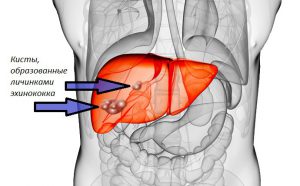
Diagnostics
Diagnosis echinococcosis is difficult due to the peculiarities of the disease. For it used laboratory and instrumental methods of investigation, as well as take into account the occupation of the person.
The laboratory diagnostic methods include:
- complement fixation - RAC;
- indirect hemagglutination reaction - IHA;
- proba kaccon.
These studies reveal the presence in the blood of human specific proteins - antigens, characteristic echinococcosis. Besides, at diagnosis is taken CBC. It is important to such factors:
- ESR - erythrocyte sedimentation rate. In the presence of the disease, this figure will be higher than normal.
- The concentration of eosinophils - in parasitic diseases, she always raised.
While using modern special equipment for surveys is difficult to diagnose echinococcosis, but it is used to determine the amount of cysts, as well as pathological processes, that occur in the affected organs. Apply such diagnostic methods:
- Ultrasound procedure.
- Chest X-ray.
- CT scan.
Laparoscopic diagnostic method is invasive and is used for detecting superficial hydatid cysts and liver size determination.
Treatment
How to treat hydatid disease? To get rid of this parasitic disease surgical treatments are applied. Required before and after the operation is carried out drug therapy. the drug is used more often than mebendazole. The dose is adjusted individually.
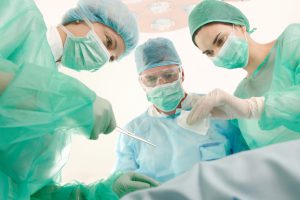
Treatment by surgery involves complete removal of cysts together with its contents and its surrounding tissue changes. But such manipulations are possible only in the event, If the cyst is small size and is located near the surface of the affected organ. If the cyst is located deep in the body, it can not be deleted, since in the course of the operation is a risk of damage to blood vessels and bile ducts. In this case, it punktirujut, liquid aspirated and discarded child bubbles, chitin shell. Then the cavity is disinfected and sutured formalin solution.
Attention! With this operation the most important point is to isolate the organs and tissues from cystic fluid, since it hit on other organs can lead to the spread of parasites throughout the body through the bloodstream.
Is it possible to cure non-surgically?
Important is the answer to the question, whether the treatment of echinococcosis is possible without surgery. It is especially relevant when multiple cysts, where surgery is not possible. But, Unfortunately, Echinococcus treatment with medication does not bring tangible results. In rare cases, you may notice a stop cyst growth or decrease. But "disappear" with the help of drugs or traditional medicine cyst can not.
Basically, this method of treatment is used as a prevention of echinococcosis recurrence after surgery.
How to identify the infection in children?
Hydatid disease in children is detected mainly by chance, when depositing assays for identifying the parasite or radiograph for diagnosing other diseases. But there are signs of echinococcus, indicating the presence of the disease. It is worth to pay attention, if the child has observed such changes:
- Abdominal pain, nausea and vomiting, diarrhea.
- Weakness, reduced school performance. The child becomes difficult to focus on anything.
- Cough, often night, chest pain, dyspnea observed in pulmonary echinococcosis.
- Possible periodic eruptions, observed skin yellowness.
- decreased appetite, baby is not gaining weight or lose it.
- Severe headaches, if the cysts are located in the brain.
Generally, diagnosis and treatment of echinococcosis in children is the same, as in adults.
disease prevention
Echinococcus treatment a person is subject to certain rules. Firstly, you need to strictly follow the hygiene after contact with animals, time to conduct deworming of domestic animals. It must be remembered about the importance of washing hands before eating food, after using the toilet.

Prevention Echinococcus includes such steps, how careful thermal processing meat, Boiling water from any natural source, Wash fresh fruits and vegetables.
By following these simple rules, the risk of infection will decrease echinococcus. And any disease is easier to prevent, than cure.
Echinococcus in humans - a chronic disease, which for a long time may be asymptomatic, and symptoms appear as ambiguous, that may interfere with the proper diagnosis. But to identify and treat Echinococcus need as soon as possible, to avoid a life-threatening disease development.



